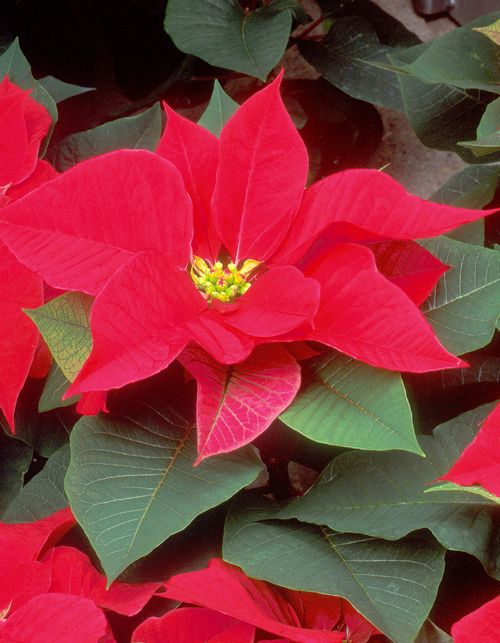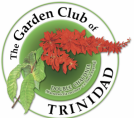POINSETTIA
The Universal Christmas Bloom by Dr. Johnny Lee

During the Yuletide season, homes all over the world are decorated to celebrate the birth of Christ. For centuries, Old World flora such as evergreens, holly, mistletoe, rosemary and bay have been used as decorations during this festive season: but from our part of the world has come the poinsettia, which is now so popular worldwide, it is known as the universal Christmas bloom.
In the United States alone, over 52 million poinsettias are sold annually – more than all other potted flowering plants combined. In the southern Caribbean, the demand is met by Trinidad’s Undercover Nursery, which ships thousands of plants up the islands every year.
Most Caribbean plant shops now carry poinsettias in colors such as creamy white, yellow, pink, brilliant red and even red with white splashes, in pots ranging from four to ten inches in diameter; so the annual chore of sprucing up your home is much easier now with the availability of these cheerful holiday plants. You no longer have to hurry to put up your tree to get that Yuletide atmosphere – just place a few poinsettias in strategic locations around your home and you have an instant Christmas décor.
The Legend Native to Central America and tropical Mexico, the poinsettia has a legend behind it: A long time ago, a poor peasant girl in Mexico had no gift to place before the altar of the Virgin and the Christ Child on Christmas Eve. Not wanting to go to the church empty handed, she gathered some bushes from the side of the road. As she placed them on the altar, a miracle happened! The bushes burst into bright, beautiful blooms of brilliant red!. And so, in Mexico the poinsettia became known as “Flor de Noche Buena” or “Flower of Christmas Eve”.
History and Development The botanical name, Euphorbia pulcherrima, plays second fiddle to the popular name poinsettia – a tribute to the nineteenth century botanist Joel Roberts Poinsett, the first ambassador of the United States to Mexico. During his posting in Mexico from 1825 to1829, Ambassador Poinsett got to appreciate the beauty of the plant which never failed to flower for Christmas. At the end of his stay, he took cuttings back to his home in South Carolina, where he propagated them in his greenhouses, distributing plants to his horticultural friends and fellow botanists. That was the start of the popularizing of the poinsettia as we know it today.
The original poinsettias were red and grew to heights of up to ten feet. These can still be seen in tropical gardens, but intensive hybridizing has created dwarf, compact cultivars in a variety of colors for indoor decoration especially for Christmas. The Myth Contrary to widespread belief, the poinsettia is not poisonous. In 1919 a two year old child in Hawaii had convulsions and died after allegedly chewing on a poinsettia leaf. The attending doctor, not having modern diagnostic aids, attributed the child’s death to poison contained in the leaf, thereby starting one of the longest running medical myths of the century.
The sap of the poinsettia, like that of many other members of the Euphorbiaceae family, can be irritating to the skin, mouth and eyes, but it will not kill. Scientists at Ohio State University came to this conclusion in 1971 after conducting extensive toxicity tests on it. There has also been no further reference to poinsettia poisoning in either medical records or newspaper reports since the incident in Hawaii. In fact, research has since revealed that the Aztecs, who called the plant cuetlaxochitle, used its latex as a medicine for fever.
Purchasing Plants When purchasing poinsettias make sure you select prime plants. What most people believe to be the flower is actually a series of colored leaves called bracts; the flowers are the round yellow berries in the center of each cluster of bracts.
Look for plants with many bracts and examine the flowers. If they look like tightly rolled balls, the plant has just started its blooming life, which can last for several months. If you see little hairs with pollen sticking out at the top, or if buds are missing, then the plant is older and its blooms will not last as long. Also, look for plants with sturdy stems and bright green lower leaves; any plant with missing or yellow leaves has undergone some sort of stress and will be weaker for it. And, of course, avoid any plant that shows any evidence of pests or disease.
Pests and Disease White flies are the main pests of poinsettias, but aphids and scales may also attack them. These pests feed on the sweet plant sap. They allow sap to get onto the leaves causing them to turn black with sooty mold, a fungal disease. The sugary sap provides the nutrients that the sooty mold needs to develop. Control the white flies and you won’t have sooty mold problems.
If you notice white flies on your plants, use a fine strong spray of water from the garden hose to wash away the eggs and immature insects. If the white flies become too numerous, they are difficult to control. You may then have to employ parasitic wasps and lady bird beetles to combat them, or even use pesticides.
Poinsettias in the Home Your newly acquired poinsettia plants can remain in bloom for months if you give them the correct amount of light and water. Keep them in a bright location but not in direct sunlight because they have been grown under cover in filtered light. The soil should be kept evenly moist, but do not allow water to remain in the saucers in which the plants are sitting.
Do not fertilize until the end of January as the plants are usually fed before sale with a slow release fertilizer which lasts for three months. You can then start feeding them with a complete general fertilizer as you would any houseplant.
After Blooming When their blooms have faded, you can plant your poinsettias in the garden or grow them as potted plants. Just make sure that, in either case, they are not exposed to any artificial light at night after September, because they are light-sensitive; they require nine to ten hours of daylight followed by fourteen to fifteen hours of darkness every day for six consecutive weeks for blooms to develop.
In many Caribbean islands, large bushes of red poinsettias and the equally lush, fine-leafed Euphorbia leucocephalo, known locally as “white poinsettia”, are often grown side by side creating a wonderful visual impact in the landscape. With the increasing use of security lights, however, this beautiful sight is fast disappearing. So, if you have a suitable location in your garden, plant some poinsettias there and help beautify your environment.
When planting poinsettias, find an unlit area that is well drained such as a mound, slope or raised bed – hillsides, if not too steep, are ideal. Dig a hole at least double the size of the root ball of the plant and fill it with a mixture of soil and organic material such as manure or compost. Prune the plants in April and again in August and you will have beautiful compact bushes for Christmas.
To grow your poinsettias as potted plants, prune them to about half their height and fertilize every two weeks with a general fertilizer. By June, when there should be a lot of new growth, transfer the plants into pots at least two inches wider than the ones they were in, and prune back the new growth leaving two to three leaves on each new shoot. Keep pinching back all new growth until late September; then let the plants grow out making sure that the regimen of bright light alternating with total darkness is instituted. By the end of November, blooming should be well underway.
Propagation Poinsettias are propagated very easily by cuttings. As they have to be pruned at least twice a year, there will be no shortage of cuttings available. Let these cuttings rest for a couple of days before placing them into a rooting medium, and before long, you will have an abundance of poinsettia plants to create a natural Yuletide atmosphere every year when they burst into bloom.
Have a happy Christmas.
THE END
